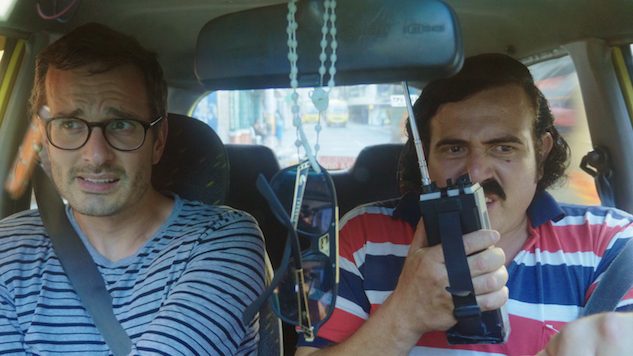Netflix’s Dark Tourist Is a Triumph of Substance Over Style
Photo: Netflix
Is there such a thing as a triumph of substance over style?
If there is, Netflix’s new docuseries might be an example of it. Dark Tourist theoretically has everything I love. It takes a totally affable curator (David Farrier), a guy whose ethical, down-to-earth manner and charming New Zealand accent are a great foil for his subject area: “dark” tourism, where people deliberately go to places most people are desperate to avoid (like combat zones, or nuclear disaster sites, or a small village terrorized by rampaging killer bees-not literally killer bees, at least not that I saw, but you get the picture). There are tourist industries set up to cater to adrenaline junkies, disaster rubberneckers, people who adore the macabre, and lovers of the kinds of history that tends to get left out of the books. Farrier covers the globe documenting them: from an unbelievably tacky JFK assassination tour in Dallas (complete with a Jackie impersonator) to busload of very antsy people carrying Geiger counters through the ruins of Fukushima, Japan, to an “interview with some vampires” in New Orleans and a Segway scooter tour of a war-torn borderland in Cyprus where if you turn one way you might crash your absurd scooter and if you turn the other way you might be shot by angry military guards.
So I was a little surprised to be underwhelmed by the series, which is a solid idea and not badly constructed. Why didn’t I completely love every minute of it? One thing that hit me was that it might have been useful to know a little more about Farrier’s angle; it was sometimes hard to tell if he is himself a “dark tourist” or someone trying to understand them (depending on the episode, you might draw either conclusion). He has a flat-affect deadpan delivery style that is faintly reminiscent of a Flight of the Conchords character. Like, he’s so laid-back it’s almost funny and then almost weird and then almost funny and then almost uninteresting and then actually funny and then slightly disaffecting and… are you with me here? That. Anyway, he’s wall-to-wall likable. And to be fair, he presents himself as a journalist, and neutrality and dispassion are good traits in a journalist in many situations. He might be slightly too dispassionate for this medium. I’m not sure I’ve made up my mind about that yet.
-

-

-

-

-

-

-

-

-

-

-

-

-

-

-

-

-

-

-

-

-

-

-

-

-

-

-

-

-

-

-

-

-

-

-

-

-

-

-

-








































